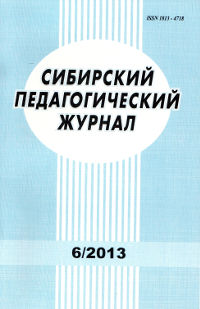Value Dominants of Professional Foreign Language Training: еnvironment approach
1. Bulankina, N. E., Malahova, N., Egorova, E., et al., 2020. Dominant values of professional development education spaces of cross-border regions in the aspect of postmodernism. E3S Web of Conferences. Rostov on Don, p. 22017. DOI: https://doi.org/10.1051/e3sconf/202021022017. (In Engl.)
2. Kwiecień-Niedziela, E., Polok, K., Mala, E., 2020. Drama Techniques as Correlators of the Level of English Language Speaking Anxiety. Integration of Education, no. 24 (1), pp. 98–110. DOI: https://doi.org/10.15507/1991-9468.098.024.202001.098-110. (In Eng.)
3. Kosheleva, I. N., 2018. Teaching English pronunciation: current trends in foreign studies. Otechestvennaya i Zarubezhnaya Pedagogika, vol. 1, no. 5 (54), pp. 135–150. DOI: https://doi.org/10.24411/2224-0772-2018-10009. (In Russ.).
4. Tareva, E. G., 2021. The Intercultural approach to training modern Intercultural approach to training modern linguists. Intercultural and multilingual education as a factor of social transformations: formation and development of Russian research school. Collection of articles. Moscow: Languages of the World Publ., pp. 237–244. (In Russ.).
5. Tsybaneva, V. A., 2008. Building phonetic and phonological competence of students in the context of modular training. Proceedings of the Volgograd State Pedagogical University, no. 9 (33), pp. 208–211. (In Russ.).
6. Shchepilova, A. V., 2013. Cognitivism in linguodidactics: sources and the prospect. MCU Journal of Philology. Theory of Linguistics. Linguistic Education, no. 1 (11), pp. 45–55. (In Russ.).
7. Bygate, M., 1987. Speaking. London: Oxford University Press, 121 p. (In Eng.)
8. Carkin, G., 2004. Drama for Pronunciation. Compleat Links, vol. 1, iss. 5 [online]. Available at: https://www.tesol.org/read-and-publish/journals/other-serial-publication...(winter-2004)/drama-for-pronunciation (accessed: 14.08.2022). (In Eng.)
9. Gasparro, M., Falletta, B., 1994. Creating drama with poetry: teaching English as a second language through dramatization and improvisation. Eric Digest, Washington DC: Eric Clearinghouse on Language Linguistics. Available at: https://www.ericdigests.org/1994/drama.htm (accessed: 14.08.2022). (In Eng.)
10. Gaudart, H., 1990. Using drama techniques in language teaching. A. Sarinee (Ed.). Language teaching methodology for the nineties. Anthology, series 24, Singapore: Regional Language Centre, pp. 230–249. Available at: https://files.eric.ed.gov/fulltext/ED366181.pdf (accessed: 14.08.2022). (In Eng.).
11. Giebert, S., 2014. Drama and theatre in teaching foreign languages for professional purposes. Cahiers de l’APLIUT, vol. XXXIII, no. 1, pp. 138–150. DOI: https://doi.org/10.4000/apliut.4215. (In Eng.)
12. Godfrey, T., 2010. Drama in English Language Teaching: a whole-person learning approach. Teacher development, teacher training and whole person learning, teacher training courses such as CELTA and DELTA and news from ITI’s global community [online]. Available at: http://tomgodfrey.wordpress.com/2010/08/15/drama-in-english-language-tea... (accessed: 14.08.2022). (In Eng.)
13. Harmer, J., 2001. The Practice of English Language Teaching. London: Longman Publ., 384 p. (In Eng.).
14. Holden, S., 1982. Drama in Language Teaching. London: Longman, 84 p. (In Eng.).
15. Kao, S. M., O’ Neill, C., 1998. Words into worlds: Learning a second language through process drama. London: Ablex Publishing Corporation, 167 p. (In Eng.).
16. Korkut, P., Çelik, Ö., 2018. Developing pronunciation through creative drama. The Language Learning Journal, no. 49 (2), pp. 147–159. DOI: https://doi.org/10.1080/09571736.2018.1491058. (In Eng.)
17. Kuimova, M. V., Uzunboylu, H., Startseva, D. A., Devyatova, K. P., 2016. Advantages of extracurricular drama activities in foreign language teaching. Ponte, vol. 72, iss. 6, pp. 52–56. DOI: https://doi.org/10.21506/j.ponte.2016.6.4. (In Eng.)
18. Maley, Al., Duff, Al., 1996. Drama Techniques in Language Learning: a resource book of communication activities for language teachers. Cambridge: Cambridge University Press, 246 p. (In Eng.)
19. Messum, P., 2012. Teaching pronunciation without using imitation: Why and how. Proceedings of the 3rd Pronunciation in Second Language Learning and Teaching Conference. Ames, IA: Iowa State University, pp. 154–60. (In Eng.).
20. Nunan, D., 1993. Designing Task for the Communicative Classroom. Cambridge: Cambridge University Press, 211 p. (In Eng.)
21. Pourhosein Gilakjani, A., 2016. What Factors Influence the English Pronunciation of EFL Learners? Modern Journal of Language Teaching Methods (MJLTM), no. 6 (2), pp. 314–326. (In Eng.)
22. Sarıçoban, A., Arslan, D., 2022. Using creative drama to improve pronunciation for young learners. Eurasian Journal of Language Teaching and Linguistic Studies, no. 2 (1), pp. 166–182. Available at: https://www.eajltls.com/index.php/home/article/view/34/14 (accessed: 14.08.2022). (In Eng.)
23. Scovel, Th., 2004. Psycholinguistics. London: Oxford University Press, 133 p. (In Eng.).
24. Slade, P., 1967. An Introduction to Child Drama. London: Longman Group Ltd Publ., 379 p. (In Eng.).
25. Tareva, E. G., 2017. Intercultural content of a foreign language textbook: Concept, texts, practices. XLinguae, vol. 10, no. 3, pp. 246–255. DOI: https://doi.org/10.18355/XL.2017.10.03.20. (In Eng.)
26. Vygotsky Lev, 1986. Thought and Language. Cambridge, Massachusetts: MIT Press Publ., 287 p. (In Eng.)
27. Watkins, B., 1981. Drama and Education. London: Botsford Academic and Education Ltd Publ., 168 p. (In Eng.).
28. Way, B., 1967. Development Through Drama. London: Longman Group Ltd Publ., 308 p. (In Eng.).
29. Wessel, Ch., 1987. Drama. London: Oxford University Press Publ., 137 p. (In Eng.)




